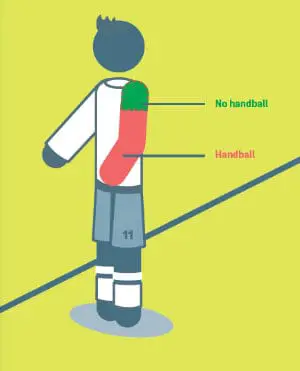Disclaimer: some of the links on this page are affiliate links. We will make a small commission on purchases made through them at no cost to you.
Like many rules in football, handballs can get confusing. One aspect which can get controversial is the part of the arm that actually counts as handball. You see a slow motion replay and the ball hits the upper arm of a player and you’re not quite sure if it’s legal or not.
So, what part of the arm is handball in football? A new rule introduced in 2020 states the upper boundary of the arm is inline with the bottom of the armpit. Any part of the arm below this boundary is considered handball.
The rest of this article looks at the offical rule, a change to the handball rule, the so-called “t-shirt sleeve” definition and implications of the arm with the offside rule.
What does the official rule state?
A new handball rule was introduced in 2020 and it states:
For the purposes of determining handball offences, the upper boundary of the arm is in line with the bottom of the armpit.
www.thefa.com/football-rules-governance/lawsandrules/laws/football-11-11/law-12—fouls-and-misconduct
A diagram is also included within the rules to illustrate where the shoulder ends and arm begins:

Before the new rule
As far as I can tell, before this new rule, there wasn’t a clear boundary. It simply stated that the shoulder didn’t count as handball but below the shoulder did.
Before VAR, the referees were left to use their best judgement to determine whether or not the ball hits the arm or shoulder. With the pace of the game, it would be impossible to make the correct decision in real-time for every call so a vague definition worked well enough.
However, with the introduction of VAR, there needed to be a more objective definition to know exactly where the lines should be drawn.
What about the t-shirt sleeve definition of handball?
You’ll often hear pundits and others talking about the t-shirt sleeve being used as the division between arm and shoulder. There’s talk about how players can wear longer sleeves to allow them to get away with what would otherwise be handballs.
I’m not entirely sure where this interpretation of the rule comes from. The official rule doesn’t mention t-shirt sleeves at all and only states that the boundary is where the arm is in line with the bottom of the armpit.
The diagram above does kind of looks like a t-shirt sleeve, but this is not the official definition at all. I guess after a few well-known pundits started talking about t-shirt sleeves, others followed and it’s stuck.
Is the same definition used for offside decisions?
You may or may not be aware that the arms don’t count as offside.
In the offical rules regarding offsides, it simply states:
https://www.thefa.com/football-rules-governance/lawsandrules/laws/football-11-11/law-11—offside
- The hands and arms of all players, including the goalkeepers, are not considered.
There’s no separate definition of what counts as offside here so as far as I can tell they use the same definition of the arms as they use for the handball rule.
Thanks for reading!
